A Travel Blog of Portugal
November 29th, 2016Lisbon re-visited
It’s late September 2016 and I’m sitting in a restaurant in a side street off the Rua do Ouro, near Rossio Square in central Lisbon. Gill and I are eating our favourite Portuguese starter cod croquette. On the next table are a couple from Finland and next to them are two visitors from Germany. Lisbon has become, in terms of visitors, one of the most cosmopolitan cities in Europe and our little group of people reflected this. Sixteen years earlier I had visited Lisbon to see my sister Cheryl and brother in law Mick who were living and working in Cascais, a coastal town, about twenty miles from Lisbon. I could remember the year because my youngest daughter Jo came with me and we celebrated her sixteenth birthday. At the time I thought Lisbon was interesting, with its buildings displaying attractive exterior wall tiles, but nothing special. Later I was to discover how wrong I was.
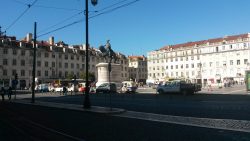
Main square Lisbon by River Tagus (Rio Tejo)
Just before coming to Portugal in 2016 I visited Waterstones bookshop in Nottingham to find an up to date travel book on Portugal. There were travel guides to Portugal but no travel books (in the genre of say Paul Theroux) of Portugal. Even the travel guides are limited in number compared with Spain, France, Italy, Germany and Holland. Yes it is a smaller country in terms of population and land mass but it has lots of hidden ‘gems’. This was my seventh visit to Portugal and each time I discover something special and new about the people, places and customs of the country.
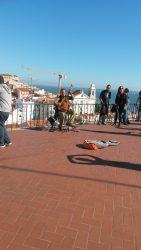
View from St George’s Castle, Lisbon
Today Lisbon is one of my favourite cities in Europe, very understated and mainly without all the expensive shops you find in London, Paris and Rome. Instead you find shops which are very individual and often selling everyday items such as sewing baskets and textile materials to make your own clothes. You can wander around, enjoy a coffee, have a drink and a meal, visit an historical building such as the castle without spending a ‘small fortune’. This is not always true of Rome or Paris. One of the most popular and inexpensive tourist trips is a ride on the traditional tram, to avoid walking up a very steep hill, to St George’s Castle (Castelo de Sao Jorge).
Little known places
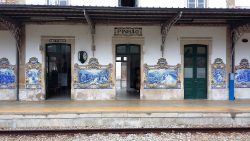
Pinhao train station
In this travel blog I want to introduce you to less well known towns such as Aveiro, Lousa, Tomar, Coimbra, Lagos, Tavira, Silves, Miranda do Corvo, Cascais, Pinhao and Porto. Although I must admit Porto is well known for its football team, wine and the Douro valley. However it is relatively unexplored compared with the millions of tourists who flock to the Algarve every year. Did you know that in 2015 there were 10 million tourist visitors to Portugal (Portuguese Tourist Board) and over a third of these visited the Algarve. I suspect the main attraction of the Algarve is the sun and the fact it is still warm in October. It is particularly popular with golfers, which you notice at the baggage handling conveyor belt at Faro airport. This is dominated by golfers unloading their golf clubs. However it is best not to pick an argument with them as they are usually in groups of at least 6 men easily identified by their V neck pullovers. I am never quite brave enough to tell them that V neck sweaters went out of fashion at least a few decades ago and at the time very popular with Val Doonican (an Irish folk singer).
Royalty by the seaside
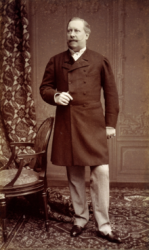
King Luis I
Apparently Cascais became popular as a seaside town when it was visited by Portuguese Royalty on a regular basis between 1870 and 1908. It was a favourite holiday spot for King Luis I (picture – Wikipedia) and Queen Maria of Savoy. It was transformed from a fishing village into a cosmopolitan and stylish seaside resort.
When I visited 16 years ago it seemed quaint, prosperous and relaxing. It even boasted a Marks and Spencer! I’m not sure if M & S are there today as they subsequently changed their business plan and closed most of their stores in Europe. My brother in law Mick was a Commander in the Navy and working for NATO which had a base nearby. Interestingly Portugal is a founding member of NATO. Mick and my sister were the perfect hosts transporting my daughter Jo and friend to all the best local swimming and sun bathing spots. I disappeared each day to explore by foot or public transport the local town and nearby Lisbon.
Lisbon was boasting lots of new roads and bridges forming an impressive transport infrastructure around the capital city. Apparently a lot of this investment was funded at the time by the European Union. It was breathing new life and energy into Lisbon and making it far easier for tourists and the local people to travel around. Did you know that Portugal only became a democracy in 1974? Prior to this a lot of the Portuguese population were relatively poor compared with residents in other Western European countries. I think this might be why the car is so popular in Portugal. It is a sort of status symbol to show you are no longer a ‘peasant’! Or at least that’s my impression.
Fado with port
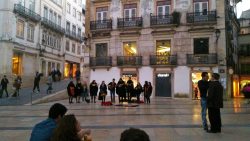
Coimbra town
I am sitting, soaking up the sun, in the main square in the university town of Coimbra in central Portugal. Believe it or not it is early November and the temperature is in the mid to high 20 degrees Centigrade. I have been here in Spring time and it has been much colder and wetter; almost winter like in comparison. Even the locals admit this is freakish hot weather. Who says there are no benefits to global warming! We are eating chips and freshly baked fish. Eating here is a delight as it is still warm enough to sit out until the early evening The meals are such good value for money particularly compared with the UK. This, however, may have changed since ‘Brexit’.
There are lots of winding alley ways leading off from the square. In the early evening we walk up
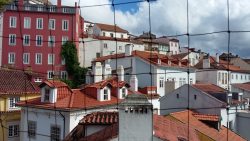
Roof tops of Coimbra
some steep steps along a narrow alley way and discover a small venue promoting ‘Fado’. Fado is a Portuguese music genre which can be traced back to the 1820’s. We buy our tickets and return an hour later for the performance. About 40 people are crammed into a small room and two men sing these Portuguese folk songs with the accompaniment of the guitar. It is very traditional and a kind of haunting sound. They project pictures on the wall of ‘old’ Coimbra when Fado was being enjoyed by the locals . The added bonus is we are given a free glass of port to savour at the end. A few months later I hear a question on the UK quiz programme ‘Eggheads’ ‘what is Fado?’; the challengers didn’t know the answer. It made me feel very superior to know the answer. It therefore appears there are some benefits to travelling outside your own country!
If only I could pronounce Lousa
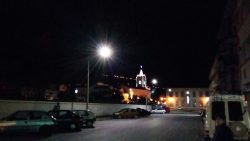
Lousa town
The next day we are travelling by local bus to Lousa. This market town is situated about 20 miles inland from Coimbra. Interestingly you buy your ticket from the local train station which our hotel was unaware of and at out first time of asking the local Tourist Information Centre. There is an assumption you are travelling by hire car if you are a tourist. This might also explain why it is almost impossible to find online an up-to-date local bus timetable. However both the bus and the train service in Portugal are comfortable, clean and much cheaper than the equivalent in the UK. They also offer me a discount for being age 65 and over. The bus journey to Lousa is relaxing as you enjoy delightful views of the surrounding hills. Also passing through traditional Portuguese towns and villages such as Miranda do Corvo.
A few days earlier I had been sitting in a lovely restaurant in Lisbon eating some delicious freshly baked Bream. The Portuguese lady next to us spoke perfect English. We explained we were due to catch the train the next day to Coimbra and from there travel onto Lousa. She then explained I was pronouncing Lousa incorrectly. However her description of Lousa didn’t seem to fit with the place we knew. Lousa is a working market town surrounded by excellent hiking and cycling countryside. It however is not yet a major tourist centre. The place she  was describing was very pretty and a popular tourist attraction also not far from Coimbra. It was a few days later we realised she was talking about Luso which appears on most of the water bottles in Portugal. Luso is the town where the bottled water is produced.
was describing was very pretty and a popular tourist attraction also not far from Coimbra. It was a few days later we realised she was talking about Luso which appears on most of the water bottles in Portugal. Luso is the town where the bottled water is produced.
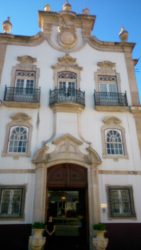
Palacio Da Lousa Boutique Hotel
We arrive in Lousa and pull our suitcases along narrow cobbled streets which is a bit awkward as not all the streets have adequate pavements. The car seems very much ‘in charge’on these streets. After a few minutes we arrive at our hotel the Palacio Da Lousa Boutique Hotel. It has a very welcoming stone built reception hall. We explain we have arrived early and realise our room may not be ready. The manager overhears our conversation and says not to worry and he will upgrade us to another room which is ready. The room turns out to be a suite of rooms magnificently furnished and decorated. I must admit this is one of the best hotels I have stayed in. The staff are always attentive and nothing is too much trouble. A milk shake delivered to our table by the outdoor swimming pool, a telephone conversation between the receptionist and a taxi driver, who doesn’t speak a word of English, to explain we want to hire him for a few days. A jacket accidentally left behind which is rescued and put to one side until my daughter can collect it a couple of weeks later.
The Palacio Da Lousa Boutique hotel has a fascinating history. Originally built under the command of Bernado Sarmento d’Eca e Alarco at the end of the 18th century. It was also a key centre for the Napoleonic Invasions. It is known that Marechal Massena, commander of the Napoleonic troops, settled in this manor, at the time belonging to the father of the Viscondessa. On 16 March 1811, Marechal Ney’s troops camped at the left bank of the Ceira River were unexpectedly attacked at night by the front of the English-Portuguese army. The French panicked and stampeded through the narrow medieval bridge and river shallows where they were defeated. Meanwhile, Massena, who was preparing for dinner, received word of his army’s disaster at the Battle of Foz de Arouce, and fled hastily, (Palacio Da Lousa Boutique Hotel website).
Did Bono stay here?
The locals tell me ‘Bono’ the pop star and the Portuguese football team have also stayed here. I wouldn’t be surprised if this is true as the service and ambiance is something special. It is exceptional good value for money. I have since re-visited the hotel twice and found my stay very pleasurable. I have also used Pedro the taxi driver on numerous occasions and its always less hassle than a hire car and much more fun and relaxing. At one time there use to be a rail service from Coimbra to Lousa but this has been closed for many years. No doubt the Portuguese equivalent of the UK ‘Beeching cuts’.
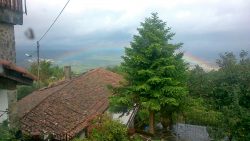
Rainbow over the hills of Lousa
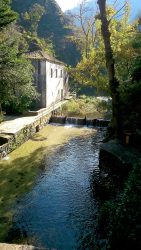
River just below Lousa Castle
Lousa is an interesting market town with a local market, offering freshly grown local food, which normally opens twice a week. Lots of Europeans including Scandinavians, British, German, Dutch, French and Belgians have re-located here. The attraction is the warm weather, cheap house prices and much lower cost of living expenses compared with their home countries. There is also an authentic Portuguese way of life compared with more touristy areas such as the Algarve. I always enjoy visiting Lousa and the surrounding towns and villages but wouldn’t want to live here. It is too parochial for me but I can see the attraction. It can also be very wet in winter but still a lot warmer than it would be in the UK.
The Schist villages
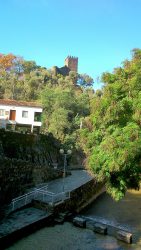
Lousa Castle – Castle of Arouce
Just a few kilometers outside Lousa is Lousa Castle. Although some would claim its proper title is the Castle of Arouce. The name of the lost village it once protected. It is surrounded by Schist villages. Their name comes from the stone the village houses are made of. There are 27 villages spread across the Lousa and Acor ranges. Nearby are also a number of river villages which tourists visit in the summer to sun bathe on their banks.
Portuguese cat citizenship test?
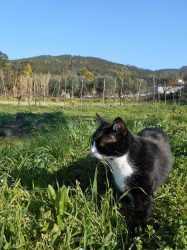
Archie
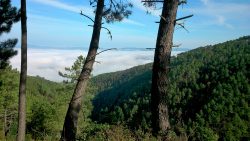
The forests in the surrounding hills of Lousa
One of my daughter’s settled in Portugal about two years ago. She lives in quite a remote village up in the hills. Having lived in the city in the UK for nine years the remote countryside of Portugal seems a remarkable contrast. Today she is surrounded by pine forests and mountains whereas before there were lots of Victorian terraces and a distant view of skyscrapers. She came here with her partner and two cats Archie and Shiva. Sadly Shiva (a rescue cat) who adored Archie was killed in a road accident outside her house. Archie still pines for Shiva today.
Archie is quite a character and has made friends with some feral Portuguese cats but also one or two enemies which means he is often in a fight. The question that puzzles me is – did Archie have to learn Portuguese cat language to communicate with the local cats? Or did he at least have to interpret Portuguese cat slang and accent. If he did he certainly has mastered the new language and I’m sure would pass the Portuguese cat citizenship test with flying colours.
Beware of the wild boar!
My daughter is trying to be as self sufficient as possible. This is helped by growing her own crops and swapping her produce for something else her neighbour has grown. The heating is a wood burner and she has access to a bore hole at the bottom of the garden The free water supply is essential in such a warm climate as otherwise the garden plants such as beetroot and onions wouldn’t survive. It is necessary to rise early in the morning at 5am to work in the garden and retreat to the shade of the house by 11am in the middle of the summer. The heat is so intense. Oddly enough the biggest challenges to growing your own food are very heavy rain, such as in the Spring, which can wash away all your plants, and wild boar. Yes wild boar! They come down from the hills and ravage the crops in the gardens without walls to protect them.

Portuguese wild boar
The wild boar is a problem in several areas of Portugal. In 2015 for example; the “uncontrolled” proliferation of wild boars in Serra da Arrábida, Setúbal, is worrying local communities who warn that the animals are “destroying protected flora, agricultural fields and gardens” and turning over rubbish bins on nearby beaches when food runs short in the forest (Portugalresident.com). Arrabida is an area just south of Lisbon.
The train to Pinhao
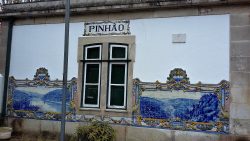
Pinhao train station
I am at the main railway station in Porto. Trying to find out from the guide at the information centre the times of the trains to Pinhao along the Douro Valley. The guide gives us the timetable showing you can complete the return journey in one day and informs us refreshments are available on the train. I remember watching the UK TV programme ‘Great Continental Railway Journeys’ with Michael Portillo describing this journey as one of the most scenic in the world. Unfortunately today is very wet and a mist descends as we depart Porto for Pinhao a village situated at the far end of the valley. We look in vain for any sight of refreshments. Fortunately we have brought some drinks and a few ‘tit bits’ to eat.
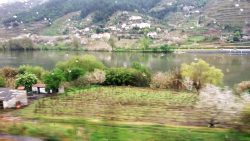
Douro Valley
The view from the window is beautiful in parts with luscious green valleys and hills flashing by. However the continuous downpour of rain does not allow us to see it at its best. For me, even allowing for the absence of sunshine, it doesn’t quite live up to its billing. My favourite railway journey is travelling from Kalka at the bottom of the Himalayas in India to Shimla. This somehow has a mystique which stays with you for the rest of your life. The 103 tunnels wind their way through dramatic countryside. Sadly the engineer Barog who built these tunnels committed suicide before the job was completed. He discovered he had miscalculated the measurements for one of the tunnels and was unable to live with the disgrace.
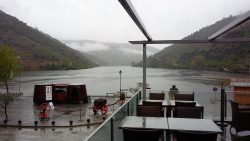
View from Pinhao over Douro River
The Douro Valley railway was completed in 1887 and originally went all the way to the Spanish border. Today this is no longer the case. Five dams were also built turning the river into a series of ‘ribbon lakes’. The furthest you can travel today by rail is to Pochino which is an isolated village station. We however disembark at Pinhao which has a pretty station decorated with attractive Portuguese tiles. The village is also a port and a popular stopping off point for boats of all sizes. It is now possible to cruise all the way along the river to the Spanish border; a distance of 200km. We sit in a restaurant overlooking the lake which is alluring even on a rainy day. The village is very quiet and the proprietors of the local shops and cafes are obviously hoping for some more sunny days to attract the tourists.
Delicious Portuguese egg tarts
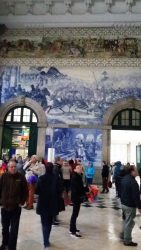
Porto train station
We return to Porto and are greeted by an almighty hail storm. Hundreds of passengers shelter in the railway station and can hear the hail stones bouncing off the roof. It is the middle of May and it is not suppose to be like this. However we can distract ourselves by observing the beautifully tiled landscapes that decorate the station waiting area. The rain eventually stops and the sunshine appears as we start our long walk back up the hill towards the apartment we are renting in a suburb of Porto. However we can’t resist stopping off for a Portuguese egg tart (Pastel de nata). It is delicious with a coffee and we sit outside a little cafe overlooking a small local park. All the food seems remarkably cheap if you eat where the local people frequent. A bowl of fish soup with bread can be as cheap as 3 Euros. This may be why more Portuguese eat out than would be the case in the UK. The warm climate is obviously another factor.
Dom Luis I Bridge Porto
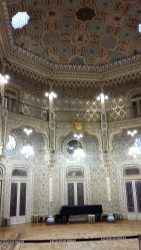
Palacio Bolsa
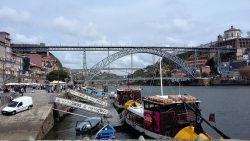 The Dom Luis I Bridge in Porto is a magnificent sight (Ponte Dom Luis I). It is a double-decked metal arch bridge that spans the Douro River between the cities of Porto and Vila Nova de Gaia. At the time of construction its span of 172 m was the longest of its type in the world. Construction began in 1881 and was completed in 1886 (Wikipedia). By the bank of the bridge is my favourite place to sit in Porto and watch the world go by. On the opposite bank are the warehouses where the port is distilled. It represents in a very vivid way everything that Porto stands for. A city with style but somehow retaining the attraction of a working place.
The Dom Luis I Bridge in Porto is a magnificent sight (Ponte Dom Luis I). It is a double-decked metal arch bridge that spans the Douro River between the cities of Porto and Vila Nova de Gaia. At the time of construction its span of 172 m was the longest of its type in the world. Construction began in 1881 and was completed in 1886 (Wikipedia). By the bank of the bridge is my favourite place to sit in Porto and watch the world go by. On the opposite bank are the warehouses where the port is distilled. It represents in a very vivid way everything that Porto stands for. A city with style but somehow retaining the attraction of a working place.
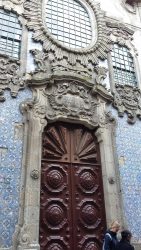
Portuguese tiles & door in side street Porto
There are many other places worth visiting in Porto such as the Cathedral and the Chamber of Commerce building but somehow the Dom Luis I bridge dominates the landscape. The Chamber of Commerce building (Palacio Bolsa) is well worth a visit with a surprising mix of ethnic influences on show. It reflects the colonial past and the rich history of a trading nation. The links with other European nations are represented through the art work particularly the historical links with the ‘British’ its old ally. The best part is the Salao Arabe (Arabian Hall) with an array of Persian designs on display. The purpose was to invite businessmen and give the impression of grandeur and prosperity and in my opinion; mission accomplished. The city can easily be explored on foot although there are a number of very steep hills to negotiate. Just throw away your travel guide book and walk the side alley ways and discover the fun of a classically styled Portuguese building hidden away.
Discovering Wolinski in Aveiro
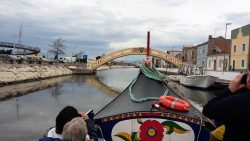
View of Aveiro canal from Gondola boat
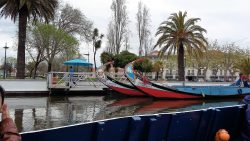
Canal side in Aveiro
We are staying in a small guest house in the coastal town of Aveiro. The guest house is owned by a Brazilian lady who has settled here with her family and seems to have established a successful business. There are still very strong links between Portugal and Brazil because of the common language of Portuguese. Aveiro is about 40 miles south of Porto and is sometimes known as ‘Little Venice’ because of its network of canals. It is on the coast and easily reached by train from Porto or Coimbra so can be part of a day trip if you don’t want the expense of staying over night. However it is well worth an overnight stay.
At breakfast we are seated next to a young man from Poland who is a visiting lecturer at the local university. He is keen to know how we are going to vote on ‘Brexit’. He understands some of the British concerns on immigration but explains Poland has also recently welcomed a million people fleeing from the war in Ukraine. It is interesting to note this fact is rarely reported in the British media or I suspect in other EU countries. However these immigrants had mainly been welcomed by the indigenous population. He thought it would be very bad for the whole of Europe if the UK left the EU. What did impress me is his knowledge of the country of Georgia. I explained I had recently been working there and he knew all about the recent war with Russia and when Georgia had become independent country. In the UK most people would struggle to even know where Georgia is on the map.
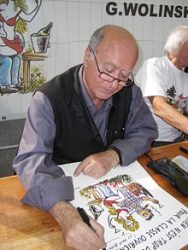
Georges Wolinski
G._Wolinski_dédicaçant_à_la_fête_de_l’Huma_2007-02 (Wikipedia)
The local museum and art gallery in Aveiro had an exhibition by Georges Wolinski the cartoonist. However you wouldn’t know this from the reception area as the receptionist seemed unaware and there was no obvious publicity. The Wolinski art work was on display in a room tucked away in the corner of the museum and from the visitors book we were the only visitors recorded that day. All the previous visitors were from countries across Europe and beyond and were very fulsome in their praise of his work. I knew very little about Wolinski except for the fact he was a cartoonist and had been killed as part of the ‘massacre’ at the Charlie Hebdo magazine office in Paris on 7 January 2015. Here was the bizarre situation of a man who had reached the age of 80 and been shot. To survive to this age and not suffer say a heart attack or stroke and then to die in such a violent way just seemed so absurd and sad.
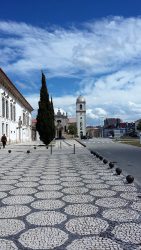
Aveiro town centre
I then did a little research on Georges Wolinski. He was born in Tunisia and his father had been murdered in Poland when he was two years old. He moved to France with his mother in 1945 just after World War II. His mother was Tunisian of Italian extraction. He started drawing political and erotic cartoons in 1960. Interestingly they mis spelt his name ‘Wolinsky’ on the plaque put up outside the Charlie Hebdo office in Paris in memory of those who had been killed. Maryse Wolinski his wife was a French writer and journalist born in Algiers. She is often described as a feminist and Georges sometimes as a chauvinist. I really liked his cartoons and drawings but they obviously offended some people. He was also a film maker. Interestingly he had very strong connections with Portugal and had visited the country many times as part of cultural events; hence no doubt the reason for the exhibition to be placed in Aveiro. I suspect Georges was deliberately provocative and his wife said after his death on the day of the murder he had some sort of premonition of what was about to happen and nearly didn’t go into the office that day. Somehow the world seems a ‘poorer’ place without his mischievous and anarchic contribution.
The wet and winding road to Tomar
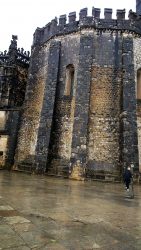
Tomar Castle – Convento de Cristo
It is early October time but the rain is relentless as we travel from Lousa to Tomar a distance of about 70 km. We are in a hire car as public transport is not feasible for this journey. We stop off for a coffee at a bar – cafe and get drenched even running a few yards from the car to the cafe. It is a question I have often asked myself ‘why can’t a British pub be replicated abroad?’ The bar is pleasant enough but somehow lacks the ambiance of the British equivalent. What the Portuguese do have in abundance are delightful coffee shops (without the alcohol). The Portuguese take the time in the middle of the day to watch the world go by and indulge in a cake. It is different from the French. No big meal and much more understated but with the unwritten statement ‘it is good to linger and do nothing of importance’.
The town of Tomar is split in two by the Rio Nabao and we cross the stone bridge to visit the Castle. I have a mug sitting by my lap top bought at the castle which is also known as the Convento de Cristo. It is a circular building with splendid views from the top of the town below. Somehow today it looks forlorn in the rain. It is however well worth a visit with parts of the building dating from 1162. What made me smile is the attempt by the attendant at the entrance to give me a free entry. Are you a senior citizen sir and over the age of 65? I answered honestly saying I was over the age of 60 but not yet 65. Apparently if I was 65 I was entitled to a free pass. He asks if I am certain of this and in the end gives me I think a ‘student’ ticket with the appropriate reduction in cost. Anywhere else in Europe they would be keen to charge the maximum fee. On one day of the week the entry to historic buildings and museums in Portugal are free. This is an excellent tradition affording families to come together to enjoy the sights.
What do you think of Airbnb?
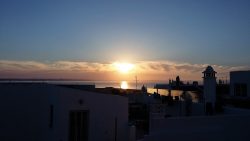
sunset in Lagos
We are staying in Lagos in the Algarve. It is still in the month of September and very warm in the day time but distinctly cooler in the evening. Down by the marina in the evening listening to a talented British jazz group is not a time to be wearing shorts. There is obviously a significant ‘ex pat’ British community living in Lagos and some of the bar workers are English. However it has a very different feel to southern Spain – the ‘ex pat’ British seem very integrated into the local community. This is not always the case in southern Spain where the ‘ex pats’ often seem to set up their own distinct communities. Our home for a week is a one bedroom apartment overlooking the sea from on top of the hill via the cobbled streets of the town centre. We have hired the flat through Airbnb and found it to be an excellent location with good amenities and a homely feeling about it. It is excellent value for money. Airbnb have come in for some criticisms in cities such as Paris. The locals complain that those staying are abusing their stay by for example having late night parties. My experience of Airbnb is of an organisation that carefully ‘vets’ the landlord and the person hiring the accommodation. If you would like to stay with Airbnb please click here
Silves – the capital of the Moorish kings
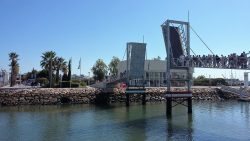
Lagos – bridge over river to the marina
Lagos is much less touristy than most places in the Algarve. It has a thriving local food and fish market and is still active in the winter months. We visited Lagos, just for the day, about ten years ago. Very little seems to have changed. We try to arrange a few day trips to surrounding areas but a hire car or taxi usually seems necessary to complete the journey. The train stations are often at least two km outside the towns they serve. Public buses do not easily connect between various towns. For example it is possible to travel by bus from Lagos to Silves via Portimao. However the timetable often means you are waiting quite a while in Portimao to make your connection. Silves is a delightful place to visit with a superb castle and a cathedral just below built on the site of the Grand Mosque. Originally, before 1249, it was the capital of the Moorish kings before it fell to Christian forces of the Crusaders.
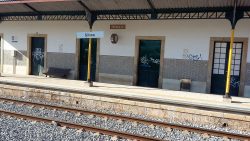
Train station Silves
We decide to travel by train from Lagos to Silves and work out how to walk from the station to the town when we arrive. It is a relaxing journey of about forty minutes passing through a number of towns and villages. Only three people disembark at Silves and two of them are English. There is no connecting bus into town. We walk with our newly acquired English friends into town which at one point means walking along a busy highway without the benefit of a footpath. They are also keen independent travellers making the most of their retirement years. All of us feel a sense of achievement in finding our way to Silves for the cost of just a few Euros. At the same time we have walked off our excess calories acquired through too many snacks and drinks.
Silves is compact but very hilly and negotiating the steep slope from the castle via cobbled streets down to the river proves quite a challenge. Walking up to the hill to the castle is hard work but not as treacherous as coming down. Perhaps I am just getting old but a few more hand rails would have made the walk so much easier. Also why do we have these shiny cobbles on the pathways which look very pretty but on a rainy day can be too slippy to hold your footing?
Faro – more than just an airport
We are staying in Faro for two nights and using it as a base to visit Tavira which is close by. Most visitors only see the town on the way to and from the airport. However it does have a distinct character and a life apart from acting as a transport hub for tourists visiting other parts of the Algarve. The waterfront and marina area is buzzing with visitors in the summer exploring the goods for sale at the open air stalls and often accompanied by live music on the outdoor stage. We stayed in Faro about ten years earlier and had memories of a delightful fish restaurant but couldn’t remember its name. We walked up several streets to find this eating place but only discovered it when we were about to leave. In fact we had passed it several times as it was on the route from our apartment to the train station. There is an irony here that seems to me to reflect what we often struggle with in other aspects of our life. What is often most important to us, whether it be relationships, work or leisure, is often on our ‘doorstep’ but we only recognise it when it is too late.
I love eating out but usually choose places down a side street rather than in the main square of a city or town. The cafe situated away from the crowds is usually better value for money and it is where the locals eat leading to some interesting ‘chats’ about what is happening in the town. The owners also have to work harder to attract their customers and therefore the food is usually excellent. Below the apartment block we are staying in is a local cafe apparently only frequented by the Portuguese. It seems too far out of the way for tourists to find it and doesn’t have the smart restaurant frontage of the restaurants in the marina area. It is however great fun just sitting there in the sun watching the locals busy with their lives as we eat a simple omelette with chips and an egg tart.
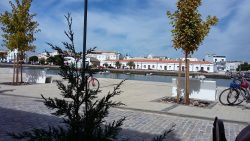
Tavira
We leave Faro early in the morning for a day trip to Tavira which is only about forty minutes away by train. It is along the coast towards the Spanish border. We have previously stayed here for a week and as we sit on the train we try to remember the places that were special on our previous holiday.
The ‘gotan project’
It is strange what we remember from a place. In my memory the key association with Tavira is the ‘gotan project’. There was a little cafe owned by a German couple which you discovered by crossing the Roman stone bridge. I can’t remember what we ate but I can picture the wonderful ambiance and the delightful haunting music playing in the background which I later discovered to be the ‘Gotan project’. Its a sort of repetitive South American jazz sound. I bought a copy of the CD which I’m playing as I write this. Somehow this first album went from an underground favourite and by word of mouth became a million selling album. Inevitably the cafe on a second visit (ten years later) was nothing like the original place and the previous owners had disappeared.
Tavira is still very laid back town but a little more touristy today and upmarket. You can still happily explore the area by cycle and eat delicious sea food at reasonable prices. We are sitting by the waterfront eating fresh sardines, salad and chips. On the table next to us are an English family who are staying at a house they have bought to escape from the business of London. Tavira is somehow less Bohemian than before but still has the ‘old world’ charm rarely found in other parts of The Algarve. We chat with a Canadian couple who are enjoying their retirement by travelling all over Portugal. They also have taken the trouble to discover the lesser known places in central and northern Portugal. They delight in sharing their travel stories and their love of Portuguese culture.
Would you like to live in a windmill?
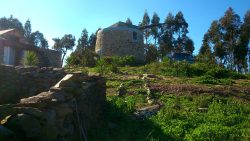
The mill in central Algarve
Up until 1970 most towns in Portugal had at least one mill. Its purpose was to ground corn and wheat to make bread and grain. This mill is in central Algarve about 40 km from the south coast an area few tourists visit. I have to admit I nearly bought it. It also had two adjoining cottages which have been mainly renovated. What it didn’t have is its own water supply in the shape of a bore hole. This is very important in Portugal. Water is stored in underground water tanks and is brought up by lorry and pumped into the tanks. This is in a relatively remote and mountainous area so it was impossible to say how difficult or expensive it would have been to find a suitable bore hole.
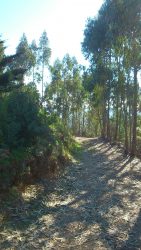
The forests of central Algarve
Inland Algarve as you head towards the hills has some delightful countryside. Water is so important in the Algarve as the summer is so hot and dry. There can be times when it doesn’t rain for weeks. The history of the windmill is not so dissimilar to England. I recently visited Sibsey Trader Windmill in Lincolnshire which is set in open flat countryside and is one of many windmills spread all over Lincolnshire. As a Lincolnshire lad I am very familiar with the windmill at Moulton near Spalding and its boast of being the tallest windmill in England. They were built with the purpose of feeding the local population and at the same time provided work for millers. The agricultural history of England and Portugal would seem to have a lot in common.
I hope you have enjoyed my tour of some of the lesser known places in Portugal. It may be you have also visited Portugal and would like to share your own observations. Or if you haven’t visited this delightful and fascinating country you feel inspired to discover its food, customs and culture. Just take a chance and explore somewhere away from the crowds and discover that little gem.
To find suitable places to stay in Portugal please visit: AllTheRooms Or to discover when to visit Portugal please click on best time to visit


Comments
Thank you for this article!
I have also been in Portugal twice (Madeira and Algarve) and it was an amazing experience!
MARIANNE FERNANDEZ
January 30th, 2017
Thanks for the thoughts, Paul – I enjoyed this, though I am now a little concerned that I have two V necked sweaters hanging in my wardrobe…
Mike Payton
April 19th, 2017
Made me feel a bit guilty, sitting here reading, rather than getting out there and exploring! I really liked the interest, variety and practical experience you relate.
On my brief visit to Portugal the only drawback was that I found the way the languages spoken made it impossible to understand, even if I knew the words.
However even I find ‘bacalhau’ somehow much more enticing than ‘cod’!
Andy Rogers
April 28th, 2017